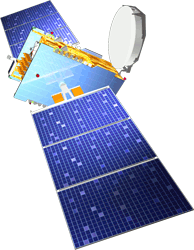 GSAT-8 | |
| Mission type | Communication |
|---|---|
| Operator | INSAT |
| COSPAR ID | 2011-022A |
| SATCAT no. | 37605 |
| Mission duration | Planned: 12 years Elapsed: 14 years, 6 months, 3 days |
| Spacecraft properties | |
| Bus | I-3K |
| Manufacturer | ISRO |
| Launch mass | 3,093 kilograms (6,819 lb) [1] |
| Dry mass | 1,426 kilograms (3,144 lb) [1] |
| Power | 6,242 watts [1] |
| Start of mission | |
| Launch date | 20 May 2011, 20:38 UTC |
| Rocket | Ariane 5ECA VA202 |
| Launch site | Kourou ELA-3 |
| Contractor | Arianespace |
| Orbital parameters | |
| Reference system | Geocentric |
| Regime | Geostationary |
| Longitude | 55° East |
| Transponders | |
| Band | 24 Ku band and 2 in L1 & L5 bands (GAGAN) |
GSAT-8 or INSAT-4G is communication satellite. It was constructed by the Indian Space Research Organisation, as part of INSAT system. GSAT-8 was launched on May 21, 2011, from Kourou, French Guiana. The rocket, an Ariane 5 was the carrier, marketed by the European Arianespace. First satellite to carry GAGAN payload followed up by GSAT-10 and in-orbit spare GSAT-15. [2] [3]
